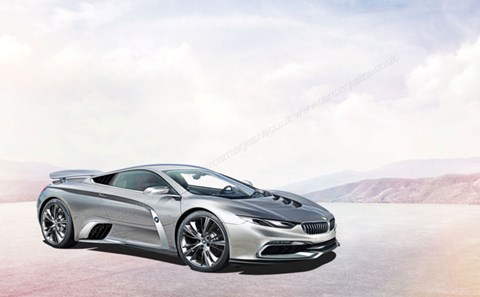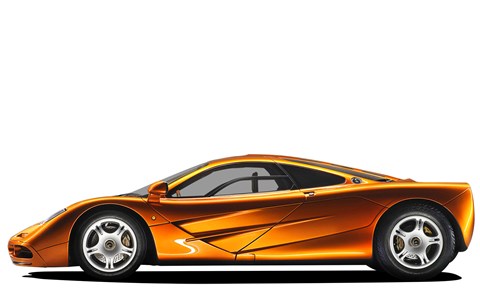► BMW and McLaren in talks
► Last callaboration was McLaren F1
► Mid-engined V8, 750bhp plan
BMW is developing a mid-engined supercar with a V8 engine – and is in talks with McLaren to put the car into production. CAR can reveal that the top secret flagship is scheduled for a Frankfurt show unveiling in exactly two years’ time, if talks with Britain’s supercar specialists are successfully concluded.
Munich has been toying with a high-octane yin to the i8 hybrid’s yang for a few years. But with 2015 bringing a new chairman, Harald Krüger, and a new boss at M Division, Frank van Meel, the idea of a BMW supercar once again has real momentum at the very top.
Another new boy, r&d chief Klaus Fröhlich, started exploratory talks with McLaren back in January. An alliance makes perfect sense. BMW – still digesting the telephone numbers investment it took to bring the i3 and i8 to market – is understandably keen to seek a top-notch supercar partner with whom to share development, rather than give M Division carte blanche on costs and strategy.
BMW/McLaren supercar: the lowdown
The supercar is scheduled to be in dealerships for 2019; a coupe is top priority, with a roadster a strong possibility. The models would be twinned with the carbonfibre monocoque of McLaren’s P16, the codename for the next-generation 650S. Our artist’s impressions by Andrei Avarvarii depict how it could look.
The two companies have previous, of course (see panel overleaf). BMW supplied the McLaren F1’s magnificent V12, and the Germans would again provide a powerplant to call a McLaren-developed rolling chassis home. Sources say BMW has plumped for its new 4.0-litre V8 rather than with a highly tuned six. Output would be boosted by no fewer than four chargers; two exhaust-driven, two powered by electric motors. This state-of-the-art engine would be good for 750bhp, and more besides. Since the V8 is not a McLaren engine, there should be no brand image conflict – though Woking might baulk at BMW embarrassing it in the power stakes.
Differentiated exterior designs would separate the two supercars. With start of production pencilled in for late 2018, there’s just about time to accommodate BMW’s needs within the P16’s architecture. Done right, the matrix should be sufficiently modular to cater for brand-specific hang-on panels, door treatments and aero concepts. BMW’s wishlist also includes a bespoke instrument panel, as well as infotainment, connectivity and driver assistance features it would share with McLaren, if so desired. BMW is not looking for an overly ambitious volume: three digits will suffice each year.

How will it be split?
Insiders claim a plug-in hybrid is not on the agenda. Mid-term, anything is possible, but for 2018 expect start/stop, brake energy regeneration and at best a mild 15kW hybrid boost.
Suspension, steering and brakes will be shared across both brands: BMW should be able to dial in its own specific calibration, with a high-speed bias for that coveted autobahn touch. BMW’s still nameless two-seater would, like the 650S, be positioned in Ferrari, Lamborghini and Aston Martin territory. The pricing would have to be beyond £150,000. After all, the deal would also need to be a solid money-maker for the Brits, who are still digesting a substantial up-front investment.
There remains a big question: why doesn’t BMW handle its proposed halo car in-house? That was the original plan for M100, a supercar intended to crown the marque’s 2016 centenary. Even though it was already well underway, then-chairman Norbert Reithofer called it off at the eleventh hour. As the driving force behind the i3 and i8, Reithofer feared the M100 would hamper BMW’s eco-focused sub-brand, which cost billions to establish. But it’s now thought a big-bore V8 supercar could co-exist with the low carbon i8, with its zero-emissions electric capability and 1.5-litre three-cylinder turbo.
The mid-engined M100, which found a strong advocate in design overlord Adrian van Hooydonk, was a striking piece of kit: wide, low, aggressive, very much a BMW and with innovative aerodynamics. By selectively directing the airflow through a front end scoop to a set of horizontal bonnet louvres below the windscreen, and from there over the roof and through ducts around the drivetrain, the wind tunnel wizards achieved a magnetic ground effect while reducing drag to the equivalent of an extra 100bhp at speed. In combination with a lightweight body and an awesome 750bhp twin-turbo V8, M100 would have given the supercar superstars a run for their money, on road and on track. But Reithofer gave the thumbs down, and the full-scale M100 disappeared.
M Division didn’t take no for an answer. Instead, they began tweaking the concept, suggested additional electric front-wheel drive and replacing the V8 with a slimmer straight-six, but to no avail. In a final desperate attempt to make the chairman change his mind, the Garching skunkworks prepared the i8 CSi (CAR, December 2014), which was in essence a rebodied and heavily reworked i8. The car did keep its trademark carbon core, but it would have needed more power and redesigned suspension for better grip and handling. The development team dabbled with four- and six-cylinder engines, and upgraded the electric motors, targeting 750bhp. The additional batteries and the more complex propulsion system brought tricky weight, cost and packaging implications. Reithofer killed the compromised concept once and for all, for failing to improve on i8 or offer something compellingly different.
But the passion to do a pure supercar, with an external partner to share the burden, burns brightly within the new chiefs. And throughout the year, car spotters loitering at the Munich factory gates have noticed a growing number of visitors, coming and going in current McLaren coupes and spiders. McLaren’s official line is that its automotive line has a ceiling of 5000 units a year. ‘We can’t build cars for anyone else, with 4000 McLarens the target by 2017,’ said a spokesman. But with its low-volume expectations, that leaves some headroom that BMW could exploit. Assuming McLaren, which is already profitable at 1500 units, deems the project worthwhile.
At this stage the plan is not cast in stone: it may still come to nothing. But according to sources within BMW’s research and development complex, the odds are very much in favour of a thumbs up. After all, this tie-up has all the elements of a clever game plan – low risk, substantial customer benefit, great brand support and ultimately two fatter bottom lines. Like G29, the Z4/Supra sports car joint-venture signed with Toyota, the successor to M100 may pave the way for another partnership with McLaren. And BMW’s portfolio may end up with a new halo car, i8’s evil twin.

When BMW met McLaren the first time
Inside the seminal McLaren F1 beats a BMW heart that’s arguably the greatest naturally aspirated road car engine – ever. Yet it came about almost by accident, provoked by an encounter between Gordon Murray and BMW Motorsport chief engineer Paul Rosche at the 1990 Hockenheim Grand Prix. Murray knew Rosche from the old Brabham-BMW days, but it was the German who suggested BMW could build the F1’s motor. The result was the extraordinary S70/2 V12.
McLaren wanted 5.3-litres but got 6.1 – within the 600mm packaging constraints – and the 550bhp target became a 627bhp reality, enough to achieve 550bhp per tonne.
Innovations included scant 3mm cylinder separation, expensive Inconel manifolds, dual injection and binning the flywheel. The silencer doubled as the rear crash structure. Whatever the engine, the F1 was always going to be legendary, but BMW power helped deliver immense, record-setting performance. When BMW and McLaren get together, magic happens.